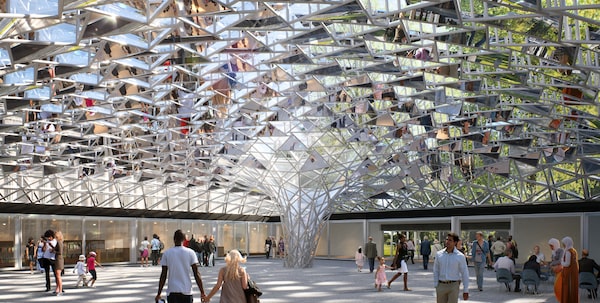
Buffalo's Albright-Knox Art Gallery is undergoing a drastic renovation and expansion.Handout
What should an art museum be? Every generation has a new answer to that question – a stony temple, a glassy pavilion. And today’s involves cafés and open doors. “I think the view of the current moment is that the museum has to perform more than as a place to view art,” the architect Shohei Shigematsu said recently from his New York office. “It’s a gathering space – a place where people exchange ideas.”
That idea has been echoing through the museum world for a decade now. And a new building project in Buffalo, N.Y., is putting the concept to the test – remaking a gallery that already represents the past century of cultural building very well. My question is: How will the soul of the place survive in all that new light?
The gallery is the Albright-Knox, an important regional museum that has one of the best 20th-century art collections on the continent. Shigematsu and his firm OMA are designing a total renovation and expansion that begins construction this winter. It opens in 2022 as the Albright-Knox-Gundlach, named after a new donor.
In many ways it echoes OMA’s 2016 addition to the Musée national des beaux-arts du Québec. Like its Quebec City counterpart, the gallery sits alongside a park (this one designed by Frederick Law Olmsted); it needs more display space for its amazing collection, and wants to become more welcoming to the public.
OMA has designed a demure new extension, an irregular stack of gallery boxes wrapped in a veil of glass and white steel. The architecture surrounds the opaque inner galleries with a spiral of sunlit ones that can house sculptures and serve as a “gathering space.”
“It’s not that new extension alone that represents the ambition,” Shigematsu explains, “but it’s the whole thing – including a new connection through to the park.
OMA is renovating all the existing Albright-Knox buildings; they encapsulate the history of art museums in North America. Its first structure, completed by local architect E.B. Green in 1905, is in the neoclassical Beaux-Arts style. It is a temple for art, set on a plinth; you would enter it by mounting a grand stair.
The gallery expanded in 1962 with an addition by Gordon Bunshaft of Skidmore, Owings & Merrill. SOM was among the leading American architects of the mid-century; Bunshaft was the firm’s star designer and a Buffalo native.

The courtyard be capped by a conical, many-faceted glass lid by the Icelandic-Danish artist Olafur Eliasson along with Sebastian Behmann.
The 1962 building is a fortress clad in white Vermont marble. Its galleries are organized around a central courtyard, and it has almost no windows that face outward (these few are black reflective glass).
To be sure, that addition is arranged to complement the older building. But Bunshaft’s design “was an internalizing effort,” Shigematsu says. “Modernism was at the height of its ideology and nobody questioned it.”
“But as architects we all live in moments where past ambitions need to be rethought.”
One question is whether the current project is going too far in rejecting the past. The first version of this redesign, presented in 2015, certainly did. It obliterated half of Bunshaft’s building. Local heritage preservation advocates stepped in – defending the Modern architecture – and the gallery and OMA quickly changed tack.
The result is much improved. They’re replacing the front parking lot with a new green space by eminent landscape architects Michael Van Valkenburgh Associates. The new building is off to one side; it reaches out an elevated, glassed-in walkway that snakes above the grass and slides into the granite 1905 building.
As for the Bunshaft building, it gets to keep its courtyard. It will now be capped by a conical, many-faceted glass lid, which is in fact a sculpture by the Icelandic-Danish artist Olafur Eliasson along with Sebastian Behmann. In it, “you will be able to see reflections of the outside world,” Maria Scully-Morreale, the gallery’s communications director, told me.
As she said this, we were standing in one of the rooms in the 1962 building, which had just closed to the public. Elsewhere, the collection was being packed up; a fantastic 1952 Jackson Pollock had already left, and a couple of minor Impressionist works stood in crates against the wall.
I couldn’t help feeling a slight sense of loss. Morreale’s words capture the thrust of this project, which is highly competent and also useful. The A-K will get all sorts of logistical needs addressed; its new galleries will be fully physically accessible; its educational programs will no longer be in a basement. Light will shine in.
But I couldn’t help feeling a sense of loss. Bunshaft’s string of narrow gallery spaces have always seemed perfect to me. It is compact and constrained, which has advantages. You encounter one painting, or photograph; you move on to the next; and so on until you reach the courtyard and have lunch. It demands a focused attention, and it is a place apart from the outside world. Art should be accessible to all, connected to the world in every sense. But there’s also a value in seclusion and stillness.
Live your best. We have a daily Life & Arts newsletter, providing you with our latest stories on health, travel, food and culture. Sign up today.
 Alex Bozikovic
Alex Bozikovic